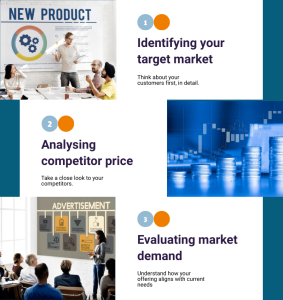


Blogs I published 10 June 2024 I Dirk Hoogenboom
A Five Step Guide to Determining the Optimal Product Price
Optimal product pricing is a balancing act: you need to provide value for customers while ensuring profitability for your business. While this may seem like an erratic guessing game, there are steps you can take to make sure you’re in line with current market trends and assigning appropriate value to your product. This requires careful evaluation and strategic planning. By implementing the five steps laid out in this guide, you can be confident you’re on the right track to optimizing your pricing for long-term success.
Step 1: Market Research
Demystifying your respective market is vital for any business venture, especially one that aims to stay ahead of the curve. This is best done through comprehensive market research. Getting to know the dominants of your playing field will provide you with the information you need to strategically position your business. To lay the groundwork effectively, focus on the following.
Identifying Your Target Market
o You’ll want to first think about your customers, in detail. Conduct surveys and focus groups to find out their characteristics. Who are they? What are their needs, preferences or habits? What are their core values? What is the perceived value of your product? How sensitive are they to pricing changes? The more you know about them, the better equipped you are to set an appropriate price for your offerings in your market.
Analysing Competitor Pricing
o Next, take a close look at your competitors, find out what they’re charging for similar products and learn from successful ones. Getting benchmarks of their value propositions will help you determine the prevailing trends, differentiate your offer and clear up how your business could stand out within the existing market.
Evaluating Market Demand
o Is there a genuine need for what you’re offering or are you entering an already crowded market? Gauge industry trends and customer habits to get a read on potential gaps in your field. Understanding how your offering aligns with current needs will help you establish the optimal price point, whether it’s capitalizing on high demand or offering competitive pricing.


Step 2: Understand Your Costs
Building on comprehensive market research, you now need to go through the books and gain core information on your business, which involves more than tallying up expenses. Knowing your costs allows you to make informed decisions for both market launch and sustainability. Pricing will very much dictate your financial structure, so gaining clarity on the numbers from the get-go means ensuring long-term profitability.
Fixed vs. Variable Costs
o Every business incurs costs, but not all costs behave the same way. Fixed costs remain constant regardless of production levels (e.g. rent, salaries, loans, insurance premiums) while variable costs depend on production volume (e.g. materials, labor, shipping). Taking both into account greatly impacts pricing strategies and helps maintain financial stability.
Calculating Total Costs
o Once you’ve identified fixed and variable expenses, calculating total costs means adding them up for a specific business period (e.g. month or quarter). This way you assess overall profitability and identify cost-saving opportunities, i.e. set competitive prices that cover expenses and generate profit.


Step 3: Consider Your Business Goals
Now it’s time to leverage the pricing strategy against your business objectives. This step is all about your future framework: are you leaning towards an in-and-out scheme to turn a quick profit or playing the long game, aiming for steady growth? The answer should guide your pricing decisions.
Short-Term vs. Long-Term Goals
o A short-term approach usually initially relies on lower prices, which achieves the „quick market share“ goal. However this might also make it harder to achieve profit margins in the long run. That’s why, for long-term success, the name of the game is profitability. If you’re set on growing success, your price points need to assure you’re both covering your costs and generating a healthy return.
Profit Margin Targets
o One thing is clear: you need to make money. But saying that and putting a specific number down are two very different things. Profit margins bridge this gap by quantifying your pricing strategy, accounting for the percentage of revenue after all expenses. Clearly establishing your targets and reviewing relevant data on your business is the most reliable way to determine if you’re hitting your mark. Start with achievable goals and adjust them as your business evolves and market conditions change.
Market Penetration vs. Skimming
o Are you aiming for rapid market share growth or maximizing early profits? Depending on your business objectives, you’re opting for either market penetration or skimming. The former is a low-entry principle that attracts a large customer base with a lower initial price. The latter, inversely, is a high-impact strategy that sets a premium initial price, maximizing profits early on and then lowering the price in subsequent stages.


Step 4: Choose a Pricing Strategy
Imagine your product sitting on a shelf with a bare price tag. Slapping a random number on it won’t do, so how do you accurately assign value? A quick workaround doesn’t exist, but by getting familiar with different pricing strategies you’ll get a clearer take on how to approach this dilemma and gradually work out which one fits your business best.
Cost-Plus Pricing
o Also known as markup pricing, this strategy determines the final selling price by adding a markup on top of the cost it takes to produce one unit. It’s a straightforward and consistent approach that works for many businesses, but doesn’t factor in customer perception or competitor pricing. Think retailers, service providers and small businesses.
Value-Based Pricing
o Relying on the old adage that a product is worth whatever the customer is willing to pay for it, value-based product pricing prioritizes its perceived value. This means setting prices based on how much customers value the product’s benefits which requires a thorough understanding of your target market. Think luxury, tech or SaaS.
Dynamic Pricing
o An alert and flexible approach, dynamic pricing adjusts product value based on real-time market conditions. This data-driven strategy takes into account market demand, competition, customer behavior and other external conditions to optimize revenue. By responding quickly to changes in the landscape, businesses remain competitive, thus maximizing profits. Think transport, hospitality or event-management.


Step 5: Test Your Pricing and Adjust Accordingly
After taking previous steps into consideration, you’ve come up with a figure that feels right. Great! But this isn’t a one-time decision. Quite the opposite, pricing is a process you’ll need to revisit regularly. You may be set for the time being, but start thinking about upcoming market fluctuations and optimizing price points to keep your business competitive and profitable. There’s several ways to do that.
Implementing A/B Testing
o A comparative method that aims to see which price ultimately fares better with customers. The customer base is split into a control group and a test group. The control group sees the current price while the test group sees the price you’re considering implementing. By comparing sales, revenue and conversion rates data in each group, you can make informed decisions on pricing.
Gathering Customer Feedback
o Listening to your customers can provide better insights on your pricing than going over the numbers. Surveys, focus groups or reviews can provide valuable information on your strategy so don’t shy away from getting direct feedback. Just make sure to act on it as adjustments will likely impact customer satisfaction and loyalty. Learn more about customer satisfaction research.
Monitoring Market Trends
o Keeping an ear to the ground is vital for relevant pricing. This means staying informed on new trends, competitor moves, consumer behavior and economic shifts to make sure that your pricing stays relevant. Consult industry market reports, relevant data and social media. By being proactive and adapting your pricing strategy on the go, you can ensure your business remains at a competitive advantage.



Read more about the subject

Fresh Insights Await
Our latest reports
Delve into the newest findings across various market segments, crafted for a cutting-edge overview. Explore our latest reports, brimming with up-to-date data, trend analyses, and in-depth examinations, all tailored to provide you with a comprehensive understanding of the current market dynamics.
Construction
Home Improvement
Installation











